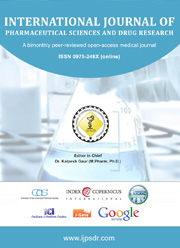Ethanolic Extract of Alternanthera Sessilis: A Potential Therapeutic Agent for Behavioral Improvements in Reserpine-Induced Parkinsonian Rats
DOI:
https://doi.org/10.25004/IJPSDR.2024.160215Keywords:
Alternanthera sessilis, Parkinson's disease, reserpine, behaviour, body weight, locomotion, grip strength, muscle coordinationAbstract
The present study evaluated the potential of an ethanol extract from Alternanthera sessilis to alleviate reserpine-induced Parkinson's disease (PD) like behavioural manifestations in rats. The animals were grouped into five: a control group, a group receiving only reserpine, a group treated with levodopa and carbidopa, and two groups given different doses of the Alternanthera sessilis extract. Reserpine was used to mimic PD symptoms, while the extract was administered orally at two different concentrations. The behavioral tests were conducted to assess locomotor activity, grip strength, catalepsy, and rearing activity. Locomotor activity was measured using an actophotometer, where interruptions in light beams caused by the rates were recorded over a 10-minute period. Grip strength was evaluated using a rotarod apparatus, measuring the time taken for rats to fall off individual rods. Catalepsy was assessed through a bar test, measuring the time for rats to descend from a horizontal bar to the base. Rearing activity was observed in a round open field arena, with parameters including the occurrence rate of rearing, general movements score, and duration spent in the center of the arena. The results revealed administration of reserpine led to a decrease in body weight, locomotor activity, muscle coordination, catalepsy score, rearing activity, and grip strength compared to the control group. Conversely, treatment with levodopa and carbidopa resulted in increased values for these parameters. Importantly, administration of Alternanthera sessilis extract showed a dose-dependent reversal of the effects induced by reserpine, with significant increases observed in body weight, locomotor activity, muscle coordination, rearing activity, general movement, and grip strength, indicating its potential therapeutic effects. In conclusion, the present study results suggest that the extract from the Alternanthera sessilis plant might protect brain cells and improve symptoms of Parkinson's disease. However, more research is needed to understand how it works and if it can be used safely and effectively clinical trails.
Downloads
References
Ragavan O, Chan SC, Goh YE, Lim V, Yong YK. Alternanthera sessilis: A Review of Literature on the Phytoconstituents, Traditional Usage and Pharmacological Activities of Green and Red Cultivar. Pharmacognosy Research. 2023;15(4).
Hwong CS, Leong KH, Aziz AA, Junit SM, Noor SM, Kong KW. Alternanthera sessilis: Uncovering the nutritional and medicinal values of an edible weed. Journal of Ethnopharmacology. 2022;115608.
George DR, Whitehouse PJ. American dementia: Brain health in an unhealthy society. JHU Press. 2021.
di Biase L, Pecoraro PM, Carbone SP, Caminiti ML, Di Lazzaro V. Levodopa-induced Dyskinesias in Parkinson’s disease: An overview on pathophysiology, clinical manifestations, therapy management strategies and future directions. Journal of Clinical Medicine. 2023;12(13):4427.
Li Y, Yin Q, Li Q, Huo AR, Shen TT, Cao JQ, Liu CF, Liu T, Luo WF, Cong QF. Botulinum neurotoxin A ameliorates depressive-like behavior in a reserpine-induced Parkinson’s disease Rats model via suppressing hippocampal microglial engulfment and neuroinflammation. Acta Pharmacologica Sinica. 2023;1-5.
Qian X, Zhong Z, Lu S, Zhang Y. Repeated reserpine treatment induces depressive-like behaviors accompanied with hippocampal impairment and synapse deficit in Rats. Brain Research. 2023;1819:148541.
Kang SS, Ahn EH, Zhang Z, Liu X, Manfredsson FP, Sandoval IM, Dhakal S, Iuvone PM, Cao X, Ye K. α‐Synuclein stimulation of monoamine oxidase‐B and legumain protease mediates the pathology of Parkinson's disease. The EMBO Journal. 2018;37(12):e98878.
Sayyaed A, Saraswat N, Kulkarni A, Vyawahare N. Neuroprotective action of Smilax china ethanolic bark extract in treatment of a prominent aging disorder: Parkinson’s disease induced by rotenone. Future Journal of Pharmaceutical Sciences. 2023;9(1):79.
Vastegani SM, Khoshnam SE, Mansouri E, Hajipour S, Ghafouri S, Bakhtiari N, Sarkaki A, Farbood Y. Neuroprotective effect of anethole against rotenone induced non-motor deficits and oxidative stress in rat model of Parkinson’s disease. Behavioural Brain Research. 2023;437:114100.
Naveen KL, Bhattacharjee A, Hegde K. A Study to Evaluate the Neuroprotective property of Aqueous Extract of Mentha piperita Leaves on Haloperidol Induced Parkinsonism in Experimental rats. Asian Journal of Pharmaceutical Research. 2023;13(3):139-144.
Lim HS, Park G. Artemisinin protects dopaminergic neurons against 1-methyl-4-phenyl-1, 2, 3, 6-tetrahydropyridine-induced neurotoxicity in a Rats model of Parkinson’s disease. Biomedicine & Pharmacotherapy. 2024;170:115972.
Jivad N, Shahraki ZF, Naseri AM. An Investigation of the Protective Effects of the Hydroalcoholic Extract of Persian Yellow Rose (Rosa foetida Herrm.) on Rats with Parkinson's Disease Induced by 6-Hydroxydopamine. Herbal Medicine Journal. 2023;8(1).
Geetha KM, Shankar J, Wilson B. Neuroprotective effect of chia seed oil nanoemulsion against rotenone induced motor impairment and oxidative stress in Rats model of Parkinson’s disease. Advances in Traditional Medicine. 2023;23(4):1091-1108.
Alharthy KM, Rashid S, Yusufoglu HS, Alqasoumi SI, Ganaie MA, Alam A. Neuroprotective Potential of Afzelin: A Novel Approach for Alleviating Catalepsy and Modulating Bcl-2 Expression in Parkinson's Disease Therapy. Saudi Pharmaceutical Journal. 2023;101928.
Khan SS, Ikram R, Naeem S, Khatoon H, Anser H, Sikander B. Effect of M. Chamomilla L. tea on chlorpromazine induced catalepsy: A neuroprotective study. Pakistan Journal of Pharmaceutical Sciences. 2020;33(5).
Sabeeh ZO, Selman SM, Makkey AM. Evaluation The Antiparkinsonian Effect of Salvia Officinalis on Animal Model of Parkinson’s Disease. HIV Nursing. 2023;23(2):1175-1184.
Siddiqi A, Alam MS, Ahmad S, Alam N, Ali MS, Ansari MS, Mohsin N, Akhtar MS, AlMD, Ahamd A, Patel M. Methanolic Root Extract of Citrullus Colocynthis Ameliorate Parkinson's Disease in Experimental Animals. HIV Nursing. 2023;23(3):1179-1187.
Muthusamy S, Rajagopal SS, Ramanathan S. Protective Effect of Annona Squamosa Fruit Pulp on Motor Responses Following Intra-Medial Forebrain Bundle Injection of 6-Ohda In Rat Model of Parkinson Disease. Current Trends in Biotechnology and Pharmacy. 2023;17(2):835-849.
El-Shamarka ME, Abdel-Salam OM, Shafee N, Zeidan HM. Curcumin modulation of L-dopa and rasagiline-induced neuroprotection in rotenone model of Parkinson’s disease. Current Trends in Biotechnology and Pharmacy. 2023;26(2):139.
Downloads
Published
Issue
Section
License
Copyright (c) 2024 Liyakath Ali Syed, Balaji PV, Aravind Kumar R, Thirumaran M, Manibalan V

This work is licensed under a Creative Commons Attribution 4.0 International License.


